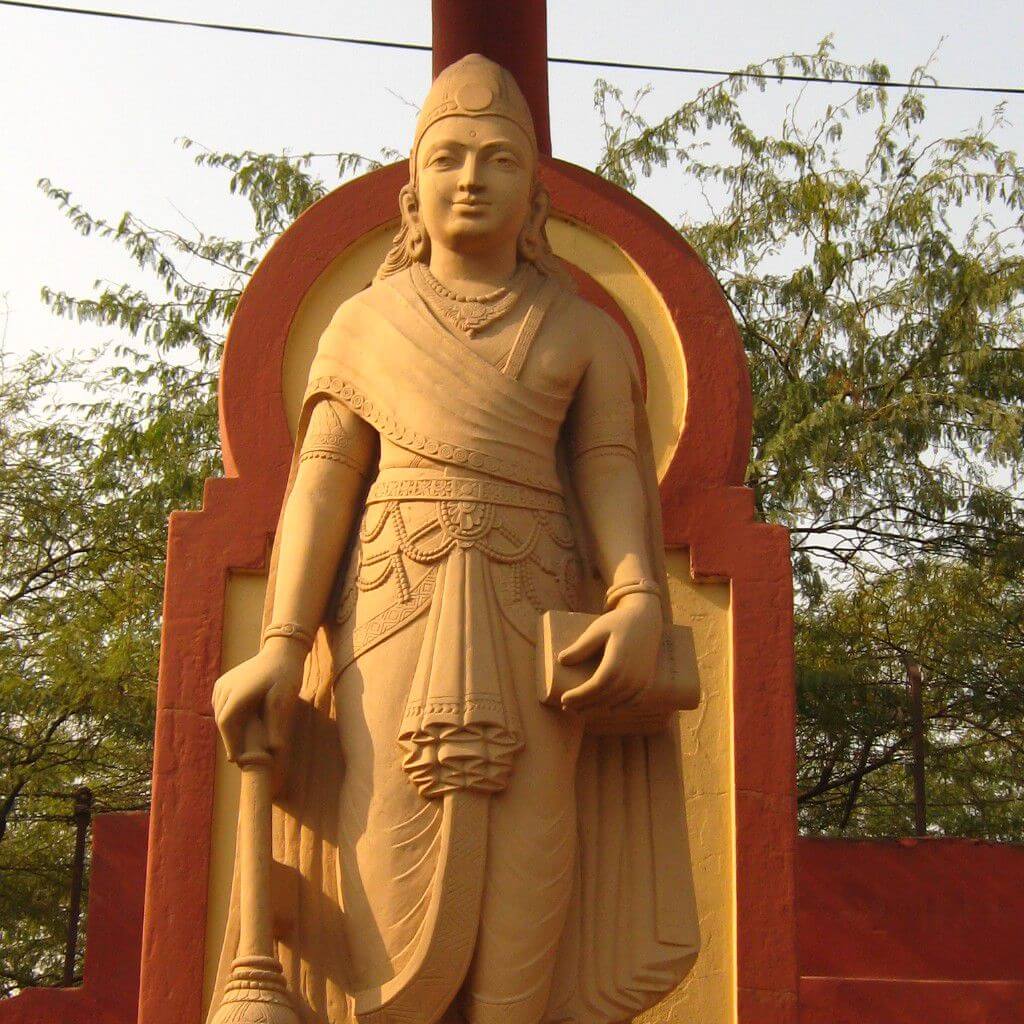Page Index
Chandragupta Maurya was the great Emperor, who built the largest Empire ever on the Indian subcontinent. Under the influence of his mentor Chanakya, he built the Mauryan Empire. In this article, we will talk about the rise of Chandragupta Maurya. And how he built an Empire that United all the 16 Mahajanpads of India. He was the first ruler who started central governance all over India.
Who was Chandragupta Maurya?
A pivotal figure of Indian history, who ended the era of the Nanda Empire. He defeated Dhana Nanda, the last emperor of the Nanda dynasty. His mentor and guide Chanakya was a great philosopher. He still holds immense influence in Indian history. Chandragupta built United India based on the principles of statecraft. Not only in India but also he extended his boundaries to the Northwest. Modern-day Pakistan, Afghanistan, Nepal, and Bangladesh everything was a part of his huge Empire. Chandragupta was the first emperor, who United South Indian states.
Mauryan Empire was so great and Chandragupta’s reign set an example of economic prosperity, reforms, infrastructure expansion, and tolerance. Before that under the Nanda Emperor taxes were high and people were unhappy. But under Chandragupta’s governance, many religions thrived like Buddhism, Jainism, Ajivika, and Brahmanic traditions. Even religions like Zoroastrianism and the Greek Pantheon were thriving. So let’s begin with this great Emperor’s biography.
Chandragupta’s Birth
There is confusion regarding the birth year of Chandragupta Maurya, as there is not enough authentic source of information. But transcripts say that he was born somewhere around 340 BC. Several texts describe the era of Chandragupta Maurya. Such as Hindu texts, Greek and Roman sources, Jain sources are there. But all of these texts vary significantly in detail.
Greek and Latin sources
The Greek and Latin literature phonetically transcribe Chandragupta referring to him with the names “Sandrokottos” or “Androcottus”. Anyhow, the Greek sources are the oldest records available. It mentions his rise in 322/321 BCE after Alexander the Great ended his campaign in early 324 BCE. These sources state Chandragupta to be of non-princely and non Warrior ancestry. But to be of a humble commoner birth.
Buddhist Sources
The Buddhist sources are written centuries later. They claim that Chandragupta and his grandson Ashoka The Great – patron of Buddhism, were of noble lineage. Some text links him to the same family of Shakyas, from which the Budha came. In addition to that, his epithet Moriya (Sanskrit: Maurya, Mayura) comes from Mora, which in Pali means peacock.
Hindu Sources
The Hindu puranic texts like Puranas, Chanakya’s Arthashastra, Vishakhadatta’s Mudrarakshasa, Somadeva’s Kathasahitsagar, and Kshemendra’s Brihatkathamanjari include in the Hindu sources. Even though there are so many texts but mostly all of them are inconsistent. Moreover, they differ hugely, while talking about the origin and ancestors of Chandragupta Maurya. The Puranas do not cover the information about the ancestor of Chandragupta Maurya. But they have an extensive discussion about the Nanda king. However, some say that Chandragupta was a descendant of Nanda king. Chanakya’s Arthashastra describes the Nanda Empire as a cruel one. Their rule was against the spiritual-cultural and military interests of the country which intrigued Chanakya to end their reign. Chanakya also said that Chandragupta returned Dharma by defeating the last Nanda king Dhana Nanda.
The Sanskrit text Mudrarakshasa mentioned the word Vishala and Kula-Hina to describe Chandragupta. The word Vishala has two meanings. One meaning is ‘the son of Shudra’, and another meaning is ‘the best of Kings’. The later commenters said that the first meaning was correct and Chandragupta had a Shudra background. But later some historians opposed the theory. They stated that the meaning of Vrishala used there is “the best of Kings”.
Jain Sources
One of the most significant Jain text Parishishtaparvan by Hemchandra describe the complete Legend of Chandragupta. It has many verses that describes the influence of Chanakya on Chandragupta’s life.
However, historians and writers mentioned Chandragupta Maurya in their texts. But none of them mentioned his birth. Even though there are so many texts about Chandragupta, there is no reliable birth year that we could find. Hence, the birth of Chandragupta remains a mystery. Approximately we can say, he was born between 340 BCE to 350 BCE.
Early life
The birth of Chandragupta Maurya is still a mystery. We have no clear information about his ancestors or parents. Some text says his mother was a Shudra woman and her profession was peacock rearing. One of the Ashokan pillars excavated from Nandngarh mentioned that the peacock was the Emblem of the Maurya dynasty. And it is probably linked to their dynastic lineage. But we know that Chandragupta was brought up and trained by Chanakya.
Chanakya was one of the councilors in the court of the last Nand Emperor, Dhana Nanda. There he was disrespected and thrown away from the court. According to some Buddhist texts, Chandragupta was an orphan and abandoned child. A cow herding pastoral family brought him up as their son. At an early age only, he impressed Chanakya with his Intelligence and talent. Chanakya understood how bright Chandragupta was. Moreover, he could see the future emperor of India in him. While leaving the court of Dhana Nanda Chanakya decided he would end the Nanda Empire. He saw the potential in Chandragupta to fulfill his dream to defeat Dhana Nanda.
Chandragupta was born in Magadha, now Patna Bihar. But Chanakya took him to Takshila for his education and training. Takshila currently is a place from Northern Pakistan. There he mentored Chandragupta for eight years through rigorous training, education, and challenges.
Building the Maurya empire
After his education of 8 long years, his first goal was to defeat Dhana Nanda. And to end the rule of Nandas. After that, he and Chanakya started roaming around to build an army. They started recruiting soldiers from different places. Dhana Nanda had a large Army of 80000 soldiers. To defeat such a huge Army they needed to build a greater Army than that. After organizing their Army they attacked Patliputra- the capital of the Nanda dynasty. But unfortunately, it was an unsuccessful attempt. Accepting their failure they returned but did not lose hope. They started to prepare again to hit back harder. But this time with more power.
Retrieving The North-West Region
Alexander the Great through his Indian campaign won the Northwest of India. After the end of his campaign in 325 BCE, he assigned Greek governments on this part. Chandragupta started to free these territories from the greeks. In addition to that, he won parts from Punjab, Pakistan, and brought them under his rule. He started to attack all the territories coming on the way to Patliputra. Trying to create a large powerful army. He won most of the North East and North of the Indian subcontinent.
The End of Nanda Empire
Chandragupta gathered an army and won other areas of the Northwest. After that, Chandragupta got back on to his initial mission – to defeat Dhana Nanda. He allied with the local kind Parvataka and attacked Magadha in 322 BCE, under the guidance of Chanakya. First, he started attacking the outskirts of the Magadha empire. Later on, he invaded Kusumpura (now Patna), the capital of Magadha. They fought the war in the guerrilla method.
However, there is no legit text that describes the total warfare between Chandragupta Maurya and Dhana Nanda. There are different descriptions of different religious texts. The Buddhists say it was quite easy for Chandragupta to take over the Nanda dynasty. He acquired a large army and with the strategies of Chanakya it was nearly a one-sided fight. But according to Jain and Hindu texts, it was a tough war for him. Nanda’s empire had a huge army of 80000 Soldiers, which made them nearly unbeatable. At last, Chandragupta Maurya ended the infamous Nanda rule and established “dhamma” (Dharma).
Marriage Alliance With Seleucus I Nicator
After the great Alexander ended his conquest in India, he went back to Babylon. There he died in 323 BCE. One of his Macedonian Seleucus I Nicator established a Seleucid kingdom in Babylon in 312 BCE. The east side of his empire and the Mauryan empire faced each other. Chandragupta and Seleucus were in a conquest to defeat each other for a much longer time. Until Seleucus proposed an alliance to Chandragupta.
The details of the alliance are still unknown. But it includes that Seleucus married off his daughter to Chandragupta. Due to this alliance, Seleucus had to give away parts of his empire. Therefore, the Mauryan empire included Arachosia (Kandahar), Gedrosia (Balochistan), and Paropamisadae (Gandhara). According to the treaty in return, Seleucus received 500 elephants from Chandragupta. These elephants helped him to win the battle of Ipsus. In addition to that Seleucid king, Seleucus sent the Greek ambassador Megasthenese to Chandragupta’s court. And during the rule of Bindusar (Chandragupta Maurya’s son), Antiochos sent Deimakos as an ambassador.
The Conquest of South
After the treaty with Seleucus, the Mauryan empire became so vast. Starting from the Northwest from the Arabian sea and extended to the east till the bay of Bengal. He had the complete northern region under his rule. After that, he started his conquest of the South. He went across the Vindhya range and attacked the Deccan dynasties. No ruler before him could win the southern parts of the Indian subcontinent. Chandragupta was the first emperor to bring India under one government and his rule. Only a small southern part was not a part of his empire – Satyapura and Cholas)
Chandragupta Maurya’s Reign
He was the first emperor to unify India. Mauryan empire was the largest empire ever existing in the history of India. Under his rule, his empire reached immense economical and social prosperity. The key mind behind crating and ruling such a huge empire successfully was Chanakya’s. He in his book Arthasastra described the statecraft policy and distribution of power. He mentioned it is very important to keep the common people happy and keep your state free from traitors.
According to the Greek ambassador Megasthenese, Patliputra – the capital city of Magadha was 9 miles long and 2 miles wide. The king mostly stayed at the place and went out for wars, public festivals, and hunting. Chanakya feared the assassination of the king. Chanakya took several measures to keep him the same. He used to frequently change his bedroom to confuse the conspiracists. The king was always under heavy security. In public festivals, the lady guards surrounded the king to protect him. This was because there was lesser probably for the ladies to be involved in any conspiracy. They took an example from the Nanda dynasty. As the last emperor Dhana Nanda assassinated the previous king to sit on the throne. Hence, made the security surrounding Chandragupta Maurya invincible.
Administration
The Mauryan empire was a structured empire, having several administrative posts for different departments. There was a council of ministers and among them, Chanakya was the chief councilor. The total Empire was divided into territories or Janpads. He built many forts in the central region of every state in order to protect the people. His administrative personnel was divided into three broad parts.
One division managed the villages and their problems. Issues like irrigation, land ownership, supplying tools, hunting, wood products, and forest laws. They also resolved the disputes of the villagers. The second department managed the cities. That included all matters related to business, trade, merchant activities, roads and markets, harbor, foreign visitors, industries etcetera. They also collected taxes and ensured if the businessmen are using correct weights and measures. It was like they had a consumer department at the time. The third administrative figure looked after the military activities. It insured to make the Mauryan Army the best. With proper training and upgraded weapons, they created one of the best armies in the history of India.
Infrastructure
the Mauryan dynasty had a great infrastructure. The key planning that Chanakya made to run the huge empire successfully included many aspects. The Mauryans were called the “great road builders”. Chanakya knew the chief rule to excel in business and trades are to build a better transportation system. If you want to trade inside the empire build roads. But if you want to trade in different continents make a great navy. Chandragupta Maurya made many roads from east to west, north to south to improve connectivity. He built a road connecting Patliputra in Bihar to Takshila in the Northwest. It was the largest highway of that time. While in the era of the great Ashoka the Maurya navy was unbeatable.
In his reign, the picture of agriculture changed. Under Chanakya’s surveillance, he built many irrigation projects, reservoirs. They ensured the continuous food supply among civilians from village to town. Also a specific supply for their huge army. This was a practice taken by the next dynasty successors too. The greatest example of their agricultural excellence is the Junagadh rock inscription of Rudraman, in Gujarat. It is from 150 CE approximately, this irrigation reservoir later was enlarged and repaired by Rudraraman.
Death
The story of Chandragupta’s death is still unclear. Different legends put different scenarios of his death. But the most convincing one is known from a transcript written by Digambara Jain. It says, one of the Chandragupta’s councilors Bhadrabahu forecasted of a 12 year-long famine. The reason behind it was the violence done by Chandragupta during his conquest. As a result, he sent a group of Jain monks to South India. Chandragupta gave his throne to his son Bindusara willingly and became a monk to join the group. Bhadrabahu and Chandragupta both stayed at a place called Shravanabelagola (presently Karnataka). There he starved himself to death willingly inside a cave. This is one of the significant places of Jain pilgrimage in current days.












